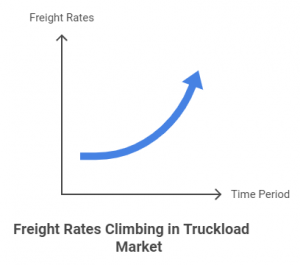
After two to three years of a prolonged freight recession, industry analysts are cautiously optimistic about a recovery in the trucking sector. While a boom isn’t anticipated, trends in freight rates, capacity, and overall trucking conditions suggest the worst may be behind us.
A Rebalanced Market Drives Recovery
According to ACT Research, the truckload market has rebalanced sufficiently for freight rates to begin climbing. Tim Denoyer, ACT’s Vice President and Senior Analyst, highlighted the significant contraction in for-hire fleet capacity and slowing private fleet expansions as key factors contributing to this shift.
“After three years in loose territory, the truckload supply-demand balance is set to turn tighter in the coming months,” Denoyer explained.
Notably, DAT spot rates (excluding fuel) in the fourth quarter are tracking 7% higher than a year ago, signaling growing market strength. Contract rates, too, are rising modestly but steadily, with similar trends observed in Cass data and fleet financial reports.
Denoyer also noted that normalizing equipment supply and potential tariff-related freight increases in 2025 could further boost demand. However, he tempered expectations, stating that while the recession may be over, the anticipated recovery will not deliver a significant boom due to the expanded private fleet capacity established over the last two years.

FTR Predicts Positive Conditions Through 2025
FTR Transportation Intelligence forecasts consistently favorable trucking conditions over the next two years. Its Trucking Conditions Index (TCI), which tracks factors like freight volumes, rates, capacity, fuel prices, and financing costs, has only turned positive twice since April 2022. However, analysts expect this to change as market conditions steadily improve.
Avery Vise, FTR’s Vice President of Trucking, explained,
“The outlook continues to be more favorable for carriers than what they have experienced for well over two years.”
FTR predicts rising capacity utilization will lead to stronger freight rates in 2025, although potential disruptions from tariffs and shifting economic policies may affect timing. Analysts remain optimistic that carriers will see gradually improving conditions despite lingering uncertainties.
ATA Tonnage Index Reflects Modest Growth
The American Trucking Associations’ For-Hire Truck Tonnage Index showed a modest rise in October, marking the third increase since July. ATA Chief Economist Bob Costello described the recovery as a “slow and choppy climb” off the recession’s bottom.
“Since hitting a low in January, tonnage is up 3%, with sequential growth in three of the last four months,” Costello noted.
Costello added that industry metrics are slowly normalizing after the disruptions caused by the COVID-19 pandemic, signaling a return to more stable market dynamics.
Driver Wages Show Recovery Momentum
The recovery is also evident in truck driver wages. The National Transportation Institute (NTI) reported the most significant per-mile pay increases since early 2023, driven by rising demand for skilled drivers. This trend reflects broader improvements across the trucking sector as carriers position themselves for growth.
Looking Ahead
While industry experts agree that the freight recession appears to be ending, they also caution against expecting rapid or dramatic changes. Instead, the recovery is expected to unfold gradually, driven by tightening truckload capacity, improving freight rates, and stabilizing economic conditions. Carriers and drivers alike can look forward to a more favorable environment heading into 2025, though challenges such as tariffs and regulatory uncertainties remain.
Source:
https://www.truckinginfo.com/10231989/are-we-seeing-the-end-of-a-3-year-freight-recession











Leave a Comment